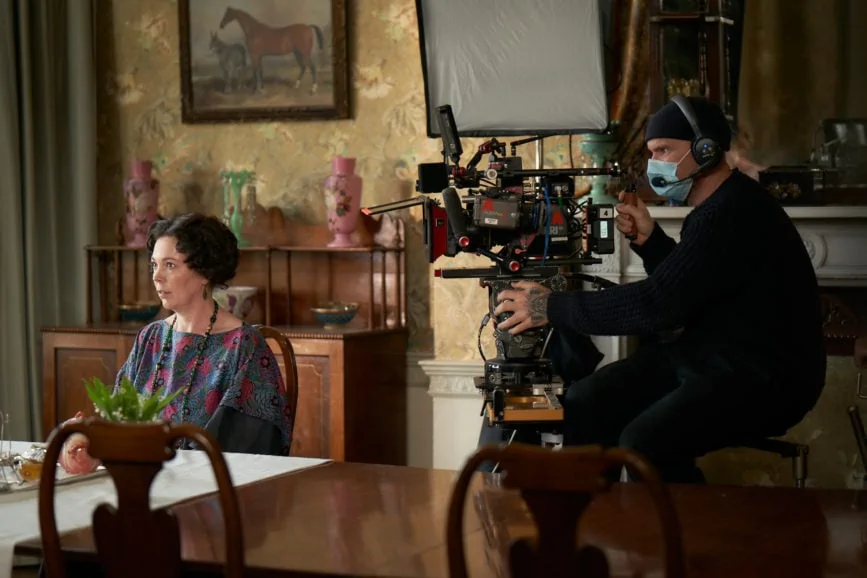Adapted by screenwriter Alice Birch (Normal People, Succession), British drama Mothering Sunday is based on the critically acclaimed, best-selling novella by Graham Swift, and directed by Eva Husson (Hanna, Girls of the Sun). Set in post-World War I England, the story follows Jane Fairchild (Odessa Young), a maid in the Niven household who is given the day off on Mothering Sunday. Whilst the Nivens (Colin Firth and Olivia Colman) attend a lunch to celebrate the engagement of their neighbour’s son, Jane spends the day engaging in one last romantic tryst with the betrothed Paul Sheringam (Josh O’Connor).
Filmed in autumn 2020, prep took place in the middle of the pandemic and under the uncertainty of lockdown schedules, allowing cinematographer Jamie D. Ramsay SASC and Husson plenty of time to get to know one another and develop their ideas. “One of the pros of shooting over COVID was that we had loads of pressure free prep time that was done over Zoom. Eva and I spent hours each day getting to know each other, and we developed a personal relationship before we broached the heart of Mothering Sunday.” This unique opportunity led to an effortless creative harmony between director and DP, “Once we got to talking about the film we seemed to be in sync and prep was a very fluid and warm process. Once Eva has you in sync, she leaves you to develop the vision and gives a lot of trust over to her HODs which allows her to focus on the wonderful performances she’s able to get.”


With colour being important in his process, Ramsay also likes to connect with other heads of departments early in prep. “Sandy Powell (Wardrobe) Helen Scott (Production Design) and Nadia Stacey (Make-Up) and I, came together to pool our thoughts on the tone of the film. Our early unification allowed us an early and solid grasp on colour pallet and overall tone.” What follows these conversations and collaborations is a treatment for the visual approach, detailing his approach to light, movement, colour, and the overall look. “This becomes my bible and I often lean on it during the process of principle photography.”
Ramsay shot 3.4K ARRIRAW, 1.66 aspect ratio format, using ARRI Alexa Mini. “I opted for the Super Baltars and Cooke S4s for the longer primes. This lens and camera combination was specifically chosen for Mothering Sunday.” He wanted to evoke a feeling of nostalgia, referencing autochrome photography of the early 1900s and Dutch Baroque paintings. “That feeling when the sea air coats your sunglasses, I wanted it to feel like you were experiencing a memory. The Baltars were the perfect choice as they are never really sharp and have loads of personality. And like autochrome photos, the edges fall off quite dramatically.”


Set in the rural landscapes of the Home Counties, most of the story takes place over one perfect spring day, throwing up particular challenges when filming during autumn in England. Ramsay reflects on the experience: “This was probably the hardest aspect of the film as we were to film during autumn which is inherently unpredictable weather wise. Having to create a visual continuity of one ‘sunny’ day was particularly tricky and often had us waiting for a gap of light to catch a moment.
“Our interior scenes were slightly easier to control and my gaffer, Julian White, had his work cut out. Using Manitou scissor lifts and cranes to host our bigger HMI lighting, he was able to move relatively quickly when we moved around the rooms.” For the romantic moments between Josh and Odessa’s characters, “I had a very specific lighting design that needed a lot of control and Julian was able to build a set-up that gave me the ability to create those atmospheric moments during the sensual love making scenes.”


For Ramsay, his relationship with the digital imaging department is one of his most important during a shoot since he prefers to work with a very specific show LUT. “I spend a lot of time with my DIT to tweak the look on a daily basis. Núria Pérez (Digital Orchard) was the perfect fit for this job because she has an inherent talent with an eye for colour and would adjust my LUT to get the dailies to a beautiful point. So much so that the dailies LUT was used for the final grade and is what you see on the screen today.”
Ramsay’s recent cinematography credits include the BBC’s adaptation of Malorie Blackman’s Noughts + Crosses, psychological drama She Will and South African military drama Moffie. When deciding which projects to work on it’s important the production feels right and engages his mind: “I would never be able to shoot something that didn’t have an angle that felt right to me. That could be the narrative, the filmmakers involved, and so on. So, when considering new projects, I go by feeling. If there’s something about it that feels right, I immediately open up to it.”
Produced by Number 9 Films and supported by Film 4 Productions, Ingenious Media and the BFI.



















